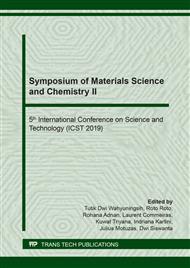[1]
FAO, Production share of spices nes by region FAOSTA, (2016).
Google Scholar
[2]
E.T. Jessica, F. Gassara, A.P. Kouassi, S.K. Brar, K.Belkacemi, Spice use in food: properties and benefits, Crit. Rev. Food Sci. Nutr. 57 (2017) 1078-1088.
DOI: 10.1080/10408398.2013.858235
Google Scholar
[3]
C. Changtam, P. Hongmanee, A. Suksamrarn, Isoxazole analogs of curcuminoids with highly potent multidrug-resistant antimycobacterial activity, Eur. J. Med. Chem. 45 (2010) 4446–4457.
DOI: 10.1016/j.ejmech.2010.07.003
Google Scholar
[4]
O.A. Hamed, N. Mehdawi, A.A. Taha, E.M. Hamed, M.A. Al-Nuri, A.S. Hussein, Synthesis and antibacterial activity of novel curcumin derivatives containing heterocyclic moiety, Iran. J. Pharm. Res. 12 (2013) 47–56.
Google Scholar
[5]
A. Amalraj, A. Pius, S. Gopi, S. Gopi, Biological activities of curcuminoids, other biomolecules from turmeric and their derivatives–a review, J. Tradit. Complement. Med. 7 (2016) 205–233.
DOI: 10.1016/j.jtcme.2016.05.005
Google Scholar
[6]
K.M. Nelson, J.L. Dahlin, J. Bisson, J. Graham, G.F. Pauli, M.A. Walters, The essential medicinal chemistry of curcumin, J. Med. Chem. 60 (2017) 1620–1637.
DOI: 10.1021/acs.jmedchem.6b00975
Google Scholar
[7]
M. Ahmed, M.A. Qadir, A. Hameed, M.N. Arshad, A.M. Asiri, M. Muddassar, Sulfonamides containing curcumin scaffold: synthesis, characterization, carbonic anhydrase inhibition and molecular docking studies, Bioorg. Chem. 76 (2018) 218–227.
DOI: 10.1016/j.bioorg.2017.11.015
Google Scholar
[8]
H. Gaffer, H.M. Mashaly, S. Hassan, Synthesis of novel dyes based on curcumin for the creation of antibacterial silk fabrics, Pigm. Resin Technol. 46 (2016) 1–4.
DOI: 10.1108/prt-11-2016-0112
Google Scholar
[9]
G. Banuppriya, R. Sribalan, V. Padmini, Synthesis and characterization of curcumin-sulfonamide hybrids: biological evaluation and molecular docking studies, J. Mol. Struct. 1155 (2018) 90–100.
DOI: 10.1016/j.molstruc.2017.10.097
Google Scholar
[10]
J. Lal, S.K. Gupta, D. Thavaselvam, D.D. Agarwal, Biological activity, design, synthesis and structure activity relationship of some novel derivatives of curcumin containing sulfonamides, Eur. J. Med. Chem. 64 (2013) 579–588.
DOI: 10.1016/j.ejmech.2013.03.012
Google Scholar
[11]
G.A. Elmegeed, H.H. Ahmed, M.A. Hashash, M.M. Abd-Elhalim, D.S. El-Kady, Synthesis of novel steroidal curcumin derivatives as anti-Alzheimer's disease candidates: evidences-based on in vivo study, Steroids. 101 (2015) 78–89.
DOI: 10.1016/j.steroids.2015.06.003
Google Scholar
[12]
C. Changtam, H.P. de Koning, H. Ibrahim, M.S. Sajid, M.K. Gould, A. Suksamrarn, Curcuminoid analogs with potent activity against Trypanosoma and Leishmania species, Eur. J. Med. Chem. 45 (2010) 941–56.
DOI: 10.1016/j.ejmech.2009.11.035
Google Scholar
[13]
G.T. Solomons, C.B. Fryhle, Organic Chemistry, Tenth ed., John Wiley & Sons, Hoboken, (2011).
Google Scholar
[14]
M. Balouiri, M. Sadiki, S.K. Ibnsouda, Methods for in vitro evaluating antimicrobial activity: a review, J. Pharm. Anal. 136 (2016) 71-79.
DOI: 10.1016/j.jpha.2015.11.005
Google Scholar
[15]
J.A. Washington, P.K. Yu, T.L. Gavan, F.D. Schoenknecht, C. Thornsberry, Interpretation of the disk diffusion susceptibility test for amikacin : report of a collaborative study, Antimicrob. Agents Chemother. 15 (1979) 400–407.
DOI: 10.1128/aac.15.3.400
Google Scholar
[16]
I. Aibinu, E. Aednipekun, T. Odugbemi, Emergence of quinolone resistance amongst Escherichia coli strains isolated from clinical infections insome Lagos Sate Hospitals in Nigeria, Niger. J. Health Biomed. Sci. 2 (2004) 73–78.
DOI: 10.4314/njhbs.v3i2.11513
Google Scholar


